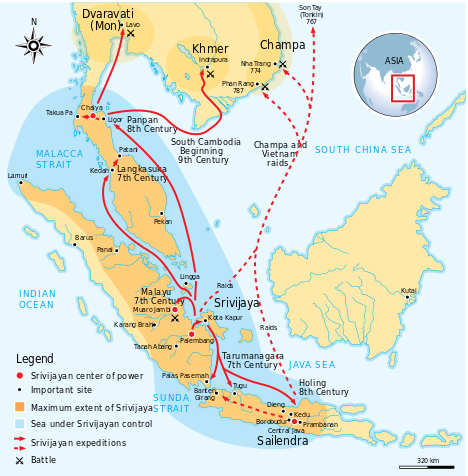The British merchants tried to bring their goods from Australia and New Zealand to the ports of India and Sri Lanka. They were obstructed by the Dutch & Muslim merchants for their movements between India and Australia. So, the British wanted a base in South-East Asia. The British managed to get the Singapore Island on lease from the Sultan of Johor of Malay. Singapore became an important port and trading center in the south East Asian region. The Dutch & British competed with each other till the Second World War. The French traders concentrated on Cambodia and Laos. The French Authorities controlled these two countries till 2nd World War. After the 2nd World War, all the countries of this Region became independent. The Sumatra, Java, Bali and Borneo islands became the republic of Indonesia. The Malay Peninsula and Northern portion of Sumatra Island formed the republic of Malaysia. In the earlier days, the movement of ships was confined between November and April. During this period the sea is calm and the voyage is free from any natural hazards. There is no cyclone or any storm between November and April. The winter winds blows towards South East Asian region from India. It helps the movement of ships to the South Eastern direction. From the Second half of March, the south eastern wind flows starts and continues up to the end of May. These winds help the ships to return to Indian ports by that period.

Some sea routes are characterized by currents and wind. Some established sea routes were followed by the merchants. Known ports and harbor along the coastal regions helped the merchant s in sail anchoring of ships and repairing of ships. The merchants also collected food items and fresh drinking waters from these ports. Exchange of goods and collection of export items also take place in these ports. The trade links between Gujarat and Bandar Abbas were there long back. From Gujarat, there was link to Kerala and Sri Lanka. The Kerala traders were having links with Egypt, Yemen, Ethiopia and Somalia through the islands of Lakshadweep. The traders from Persia, Yemen and Africa came to South East Asia through Kerala and Singapore. The merchants from Gujarat used to follow the coastal part of Western India to reach Konkan and Kerala. The Sea routes in the Bay of Bengal were mainly of two types. The first route followed the Kalinga-Banga-Burma-Malay-Thailand-Cambodia route. The 2nd route was Banga-Kalinga-Andhra-Chola-Sri Lanka-Sumatra-Java-Bali-Borneo. This route may get extended to Thailand-Cambodia-Champa (Vietnam)-China. The third route was Kalinga-Banga-Burma-Malay-Sumatra-Java-Bali-Borneo.
This route was sometimes extended from Borneo to Celvis Island, The ancient ports of Tamralipti in Banga (Bengal) played very important role in the maritime trade with South-East Asia, China and Japan. The ports like Chandbali, Puri, Manipatna and Pallur of Odisha played significant role in establishment and development of maritime trade with Burma, Thailand, Sri Lanka, Java, Sumatra, Bali and Borneo Islands. The ports like Kalingapatnam, Nagapatnam, Podukka and Konam also played significant role in the development of maritime trade with other countries. The ports of Sri Lanka also helped in expansion of the maritime trade of India. Mechanized ships and mechanized handling of goods started after the arrival of Portuguese, French and British ships to the Indian ports. Deep sea movement of ships throughout the year started with the introduction of large mechanized ships. Modern ports and harbors were developed along the eastern and western coasts of India. This helped the sea trade of India with other parts of the world.